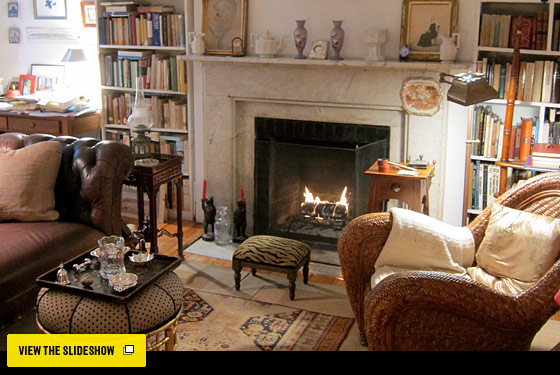

Writer-historian Jeffrey Simpson had the living-room fire going when I visited his West Village apartment on a freezing morning last week. It made having a home office especially appealing. Jeffrey has lived in this one-bedroom in an 1843 brick rowhouse for the last six years, but it feels like he has always been here. The living room has eleven-foot ceilings, original shutters, and a blue marble fireplace mantle. At one point, it would have been the single-family home’s master bedroom. The reproduction gilt mirror over the fireplace is encircled by two scaly creatures, known as Lord Nelson’s Dolphins, Jeffrey informs me. “The first of these mirrors was made for the British admiral at the beginning of the nineteenth century, when he was the great sea hero of the Napoleonic wars and the lover of Lady Hamilton.” (Photo: Wendy Goodman)

The “Theorem Painting” (c. 1835) above the chest is painted on velvet. “They were painted by young women in ladies’ seminaries in the first half of the nineteenth century,” Jeffrey says. “They were done according to a grid and, I believe, were meant to demonstrate mathematical theorems, hence the name.” Photo: Wendy Goodman

I’m always curious how people hang paintings and objects on their walls. Here the arrangement is ordered and formal, fitting for the room. The sconces hold a ceramic hen and rooster, and the large engraving, c. 1868, depicts “Authors of the United States,” including Washington Irving, Ralph Waldo Emerson, and James Fenimore Cooper. The c. 1820 drop-leaf table came from Simpson’s family farm. Photo: Wendy Goodman

His writing desk is squirreled away in a corner of the living room. Jeffrey has written ten books on American history, including American Elegy, which is about his family and a Revolutionary War land grant near Parnassus, Pennsylvania. Photo: Wendy Goodman

The Victorian Gothic glass house is known as a Wardian case. The original was designed for a London physican and botantist named Dr. Ward to be used for smuggling tea plants from China to India. They were popular for use as planters for ferns in nineteenth-century parlors. Photo: Wendy Goodman

Among the family heirlooms in his bedroom are a Victorian Gothic bed that belonged to Jeffrey’s great-great-grandparents, bedtop quilts, and a jacquard coverlet used as a curtain to mask the closet. This room would have been used as the dressing room for the master bedroom (now a living room) by the original owners. Photo: Wendy Goodman

Among the many books in Jeffrey’s collection is one called The Slant Book from 1910, which belonged to his mother when she was a child. The book is cut on the bias, and when opened, its pages slant in whatever direction the illustrated figure (a grinning baby in a run-away cart) is moving. Photo: Wendy Goodman

When I asked about the provenance of a mysterious black velvet bag with a painting of an eye held by a gold snake, Jeffrey launched into a lesson about “eye portraits”: “The first one was done in 1785 for the Prince of Wales, for him to give to Mrs. Fitzherbert, with whom he was going to enter into a clandestine marriage.” The prince couldn’t give her a conventional portrait, “So his court painter, Richard Cosway, said, “The eye is the mirror of the soul, we will give her your soul.’ So up until Queen Victoria’s reign, if you were having an illicit love affair, you gave your lover an eye portrait.” Photo: Wendy Goodman

The compact kitchen off the living room was likely once a closet. “It’s small, but very efficient,” Jeffrey says. “I thought the space needed some perking up so I hung three Blue Willow plates on the wall, and one transfer plate of Martha Washington.” Photo: Wendy Goodman

